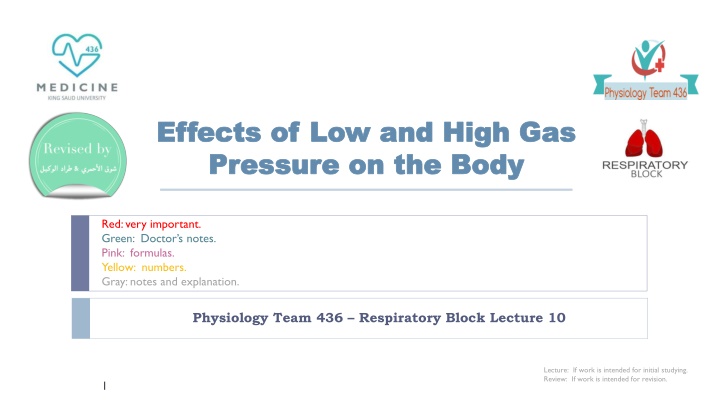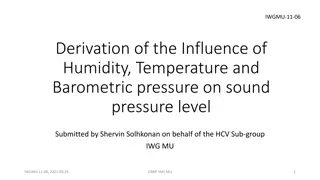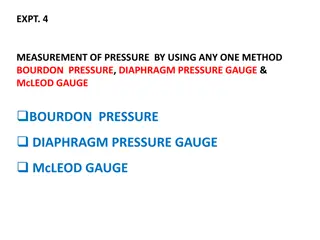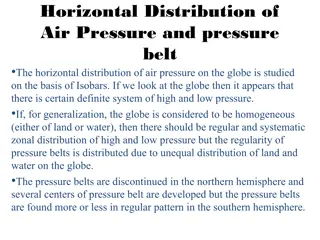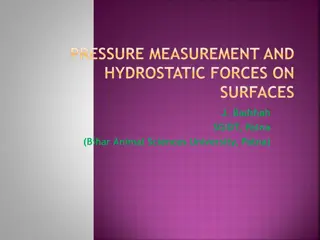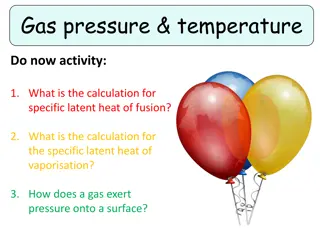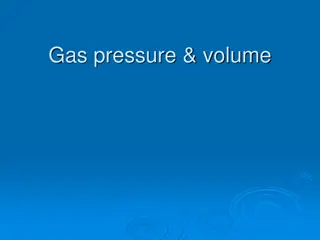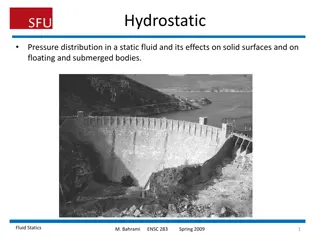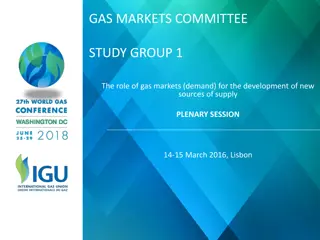Effects of Low and High Gas Pressure on the Body
This content explores the impact of exposure to low and high barometric pressures on the body, acclimatization to low pressure, decompression sickness, and effects of high nitrogen pressure including nitrogen narcosis. It also discusses the physiological changes in the body when exposed to increased barometric pressure, particularly in deep-sea diving situations.
Download Presentation

Please find below an Image/Link to download the presentation.
The content on the website is provided AS IS for your information and personal use only. It may not be sold, licensed, or shared on other websites without obtaining consent from the author.If you encounter any issues during the download, it is possible that the publisher has removed the file from their server.
You are allowed to download the files provided on this website for personal or commercial use, subject to the condition that they are used lawfully. All files are the property of their respective owners.
The content on the website is provided AS IS for your information and personal use only. It may not be sold, licensed, or shared on other websites without obtaining consent from the author.
E N D
Presentation Transcript
Effects of Low and High Gas Effects of Low and High Gas Pressure on the Body Pressure on the Body Red: very important. Green: Doctor s notes. Pink: formulas. Yellow: numbers. Gray: notes and explanation. Physiology Team 436 Respiratory Block Lecture 10 Lecture: If work is intended for initial studying. Review: If work is intended for revision. 1
Objectives o Describe the effects of exposure to low and high barometric pressures on the body. o Describe the body acclimatization to low barometric pressure. o Define decompression sickness and explain how it can be avoided. o Understand the effects of high nitrogen pressure, and nitrogen narcosis. 2
Effect of Increased Barometric Pressure (Deep Sea Diving) This exposes the blood in the lungs to extremely high alveolar gas pressure (Hyperbarism)*. When humans descend below the sea, the pressure around them INCREASES. To prevent the lungs from collapsing, air must be supplied at high pressure Under certain limits these high pressures cause tremendous alterations in the physiology of the body (i.e. nitrogen narcosis). * Exposure to high pressure means more O2 comes in, so there will be an increase in Po2 3
Cont. The surrounding pressure increases by 1 atmosphere every 10 meters (33 feet) of depth in sea water (1atm=760mmHg). How we got the numbers: You add 1atm every 10 meters below sea level: 31 meters /10 meters =3 3*1atm(in water) + 1atm(above water) = 4atm Therefore at a depth of 31 meters (100 feet) in the ocean the diver is exposed to a pressure of 4 atmospheres. Therefore, a person 33 feet beneath the ocean surface is exposed to 2 atmospheres pressure, 1 atmosphere of pressure caused by the weight of the air above the water and the second atmosphere by the weight of the water itself. At 66 feet, the pressure is 3 atmospheres, and so forth.. These problems confront SCUBA (Self Contained Under Water Breathing Apparatus)* * It has amount an of O2 which will give the diver the same PO2 at the depth he is going to ( ) 4
Effect of Increased Barometric Pressure (Deep Sea Diving) Effect of depth on the volume of the gases Boyle s Law: Compression of gases to smaller and smaller volumes. 1L (sea level) 1/2 L at 33 feet and so on. Volume to which a given quantity of gas is compressed is inversely proportional to the pressure. This is a principle of physics called Boyle s law, which is extremely important in diving physiology because increased pressure can collapse the air chambers of the diver s body, especially the lungs, and often causes serious damage. Effect of depth on the density of gases: Increase in density of gas and hence increased work of breathing. Increase air resistance in the airway like swallowing jelly instead of water Nitrogen effect at high nitrogen pressure: Has 2 principle effects: * Nitrogen narcosis (anesthetic effect). * Decompression sickness. Results in nitrogen dissolved in the tissues in a liquid form. 5 /
Nitrogen Narcosis ONLY IN MALES SLIDES When neurons become less excitable = anesthesia effect. About 4/5 of the air is nitrogen. At sea- level pressure, the nitrogen has no significant effect on bodily functions but at high pressures it can cause varying degrees of narcosis. Nitrogen narcosis has characteristics similar to those of alcohol intoxication. Nitrogen like most other anesthetic gases, dissolves freely in the fats of the body, Including the membranes and other lipid structures of the neurons. This leads to alteration of the electrical conductance of the membranes, and therefore reduces their excitability and subsequent narcosis develops. Nitrogen is a very soluble gas so when it enters through the capillaries it becomes a liquid form in the body with toxic effect Here nitrogen is shown to have similar effects to alcohol consumption. At 150-200 feet: There is a feeling of euphoria and drowsiness and impaired performance. At higher pressure: Loss of coordination and finally coma might develop. At 120 feet: The diver exhibits cheerful behavior and loses his cares. 6
Decompression Sickness (Cassions Disease) It is a syndrome caused by a decrease in the ambient (surrounding) pressure which occur in animals and men when the tissues of the body contain an excess of physically inert (does not undergo chemical reactions) gas. ) Inert gas comes out of physical solution forming a gaseous phase (bubbles), leading to symptoms and signs. During slow ascent (decompression is fast) N2is slowly removed from the tissues since the partial pressure there is higher than that in the arterial blood and alveolar gas. (To avoid getting Cassion s disease) During fast ascent (decompression is rapid) bubbles of gaseous nitrogen are released in tissues and blood, causing the symptoms of decompression sickness (The Bends Or Caisson disease) Happens when the diver gets out of the water fast. Upon Ascent The high partial pressure of nitrogen (encountered when breathing compressed air at depth) forces this poorly soluble gas into solution in body tissue particularly in fat (it has a high N2 solubility). Upon Descent 7
ONLY IN MALES SLIDES Decompression Sickness (Cassion s Disease) (The Bends) Breathes air under high pressure for a long time -> nitrogen dissolved in the body fluids increases. And because nitrogen is not metabolized by the body, it remains dissolved in all the body tissues until the nitrogen pressure in the lungs is decreased back to some lower level, however, this removal often takes hours to occur and is the source of multiple problems collectively called decompression sickness. If the diver suddenly comes back to the surface of the sea, nitrogen bubbles can develop in the body fluids either intracellularly or extracellularly -> decompression sickness. Due to decompression, gases can escape from the dissolved state and form actual bubbles; in both tissues and blood where they plug many small blood vessels. The bubbles may not appear for many minutes to hours because sometimes the gases can remain dissolved in the "supersaturated" state for hours before bubbling. 8
Symptoms & Signs of Decompression Sickness (DS) The mildest form of DS is Fatigue or drowsiness after decompression. Localskin itch. 1. 2. Other severe symptoms may occur e.g.: Bubbles in the tissues cause severe pain particularly around the joints (counts for the term bend). Neurological symptoms include paresthesia (numbness and tingling disturbances. Thoracic pains: Dyspnea (shortness of breath), substernal pain, cyanosis and cough. Bubbles in coronary arteries may cause myocardial damage (because the bubble will close the blood vessel). Decompressing sickness shock: capillaries become permeable to plasma and hypovolemia (decrease in blood volume) rapidly develop. Edema may be prominent, shock is usually complicated by pulmonary edema. 1. , itching, paralysis, and inner ear ( 2. 3. 4. 5. 6. 9
Treatment of Decompression Symptoms Put the diver into a pressurized tank to lower the pressure gradually back to normal atmospheric pressure, by using this time schedule: 10 minutes at 50 feet depth 17 minutes at 40 feet depth 19 minutes at 30 feet depth 50 minutes at 20 feet depth 84 minutes at 10 feet depth 1-Rapid recompression in a pressure chamber followed by slower decompression. (Thus simulating what would have happened if the diver was decompressed slowly) This reduces the volume of the bubbles and forces them back into solution. ONLY IN MALES SLIDES In very deep dives, the risk of decompression sickness can be reduced if a helium-O2 mixture is breathed during the dive. 11
Cont. 2- Helium is more desirable than nitrogen in deep dives because it has: 1/4-1/5 the narcotic effect of nitrogen on CNS. 1/7 the molecular weight of nitrogen. Low density leading to decreased airway resistance of diver. High diffusion through tissues (so it easily diffuses from capillary to alveoli and leaves the body). Helium is about 1/2 as soluble as nitrogen in body fluids. This reduces the quantity of bubbles that can form in tissues when the diver is decompressed after diving (avoiding decompression sickness). 12
ONLY IN MALES SLIDES High Altitude (Low Pressure) 13
Effects of Low Oxygen Pressure on the Body (Aviation-Ascend to High Altitude) At the sea level the barometric pressure (another term for atmospheric pressure) is 760 mmHg At 10,000 feet is 523 mmHg At 50,000 feet 87 mmHg. This decrease in barometric pressure is the basic cause of all the problems of hypoxia in high altitude physiology. 14
Alveolar PO2 at Different Altitudes As the barometric pressure decreases, the oxygen partial pressure decreases proportionally, leaving less than 21% of the total barometric pressure. At 50,000 feet PO2= only18 mmHg At sea level PO2= 159 mmHg At 20,000 feet PO2= 40 mmHg At high altitudes, carbon dioxide is continuously excreted from the pulmonary blood into the alveoli. Also, water vaporizes into the inspired air from the respiratory surfaces. These two gases dilute the oxygen in the alveoli, thus reducing the oxygen concentration, therefore, hypoxia develops. (CO2 + water vapor dilutes o2 hypoxia.) 15
Effects of Acute Hypoxia At 12000 feet Above 18000 feet Above 23000 feet Drowsiness Lassitude Mental and muscle fatigue Headache sometimes Occasionally nausea Euphoria (happiness) sometimes All the effects at 12000 and 1. Twitching 2. Convulsions (contraction of big muscles) Coma (the un- acclimatized person) Shortly followed by death One of the most important effects of hypoxia is decreased mental proficiency, which decreases judgment, memory, and performance of discrete motor movements. 16
Acclimatization to Low PO2 A person remaining at high altitudes for days, weeks or years becomes more and more acclimatized to low PO2. Acclimatization is important to prevent or have fewer deleterious effects on the body so it becomes possible for the person to work harder without hypoxic effects or to ascend to a higher altitude. Principle means of acclimatization: Increase in pulmonary ventilation. Increased red blood cells. (if there is decrease in O2 the kidney will respond by producing Erythropoietin which will go to the bone marrow and synthesize RBCs + Hb, so more O2 will be carried on Hb and more O2 will be transferred to the tissue). Increased diffusing capacity of the lungs. Increased vascularity of the tissues. Increased ability of the cells to utilize oxygen despite the low PO2. 1. 2. 3. 4. 5. 17
*This picture is important! CO2 18
Quiz https://www.onlineexambuilder.com/lecture-10/exam-129895 Link to Editing File (Please be sure to check this file frequently for any edits or updates on all of our lectures.) References: Girls and boys slides. Guyton and Hall Textbook of Medical Physiology (Thirteenth Edition.) 19
Thank you! . The Physiology 436 Team: Team Leaders: Qaiss Almuhaideb Lulwah Alshiha Female Members: Amal Alshaibi Allulu Alsulayhem Najd Altheeb Ghada Alhadlaq Heba Alnasser Contact us: Physiology436@gmail.com @Physiology436 20
